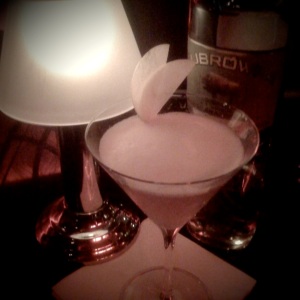MxMo: Spice

It's Monday, and that means it's about time for the international drinkblogging community to showcase all the cool things we've been playing with. This month's Mixology Monday is being graciously hosted by Craig at Tiki Drinks & Indigo Firmaments (thanks!) and - topically, for Christmas - the theme is spice. Spices belong to that category of things you won't miss until they're not there. It's literally inconceivable to eat without salt and pepper on the table. Vanilla has become so prevalent as a flavour that the word can be used to describe things that are boring, unremarkable, and yet the general connotation of spices is of exoticism, of a faraway culture.

The problem I've always found when using spices in cocktails is that I tend to focus on one in particular, with the result that the drink ends up pretty one-dimensional. This time, I made a conscious decision to use a range of spices but I also realised that combining a number of ground spices, roots, barks and the like in a shaker would prove troublesome. In order to get around the problem, I made a bottle of Krupnik, a traditional Eastern European vodka liqueur, using some honey, cloves, cinnamon sticks, vanilla pods and nutmeg. Being honest, if I'd used red wine as a base and replaced the honey with a couple of orange wedges, I'd have ended up with mulled wine - the stuff tastes like Christmas in a bottle.
There was another problem, and this time there wasn't a lot I could about it. Christmas is crazy time in the bar industry, meaning 300 covers over the course of the day in the brasserie and 12 hour shifts representing an easy day. Saturday, for example, started at 10am and finished at 2am, with just about enough time to grab a Chinese takeaway and a coffee around 5pm. All of this made it tough to find the time to prototype drinks.
This isn't something I'd call a hardship. After all, I've always been a fan of making drinks that are a simple twist on an established cocktail. From what I know of David Embury's Fine Art of Mixing Drinks, he concludes that all cocktails can be traced back to six 'essential' cocktails, so I can claim I'm on decent theoretical ground. I played with a couple of ideas - a Krupnikito could have legs, I reckon - before deciding on a simple twist on a Cosmopolitan. Substituting the Cointreau for my Krupnik, I also opted to use some Zubrowka Bison Grass vodka with the aim on contrasting the mellow floral notes with the stronger spice flavours in the liqueur.

Stargazer
25ml Zubrowka Bison Grass Vodka
25ml Homemade Krupnik honey vodka liqueur
25ml Cranberry Juice
15ml Lemon Juice
1 dash Egg whiteShake all ingredients with ice and fine-strain into chilled martini glass. Garnish with an apple fan.
This recipe will work with commercially produced Krupnik, which has less of a spice hit than my homemade variety. If you're using it, garnish with some ground cinnamon and nutmeg; flame them over the drink for effect. I'd probably recommend using less lemon juice, too. The homemade Krupnik is almost syrupy sweet.
***
The name comes from the Polish tradition of keeping a vigil for the first star on Christmas Eve, the moment which marks the start of the traditional Christmas feast. It seemed appropriate, given I'd chosen to use two Eastern European products in the cocktail.
Thanks to Craig for hosting this month's MxMo; the fun continues over at TDIF!

